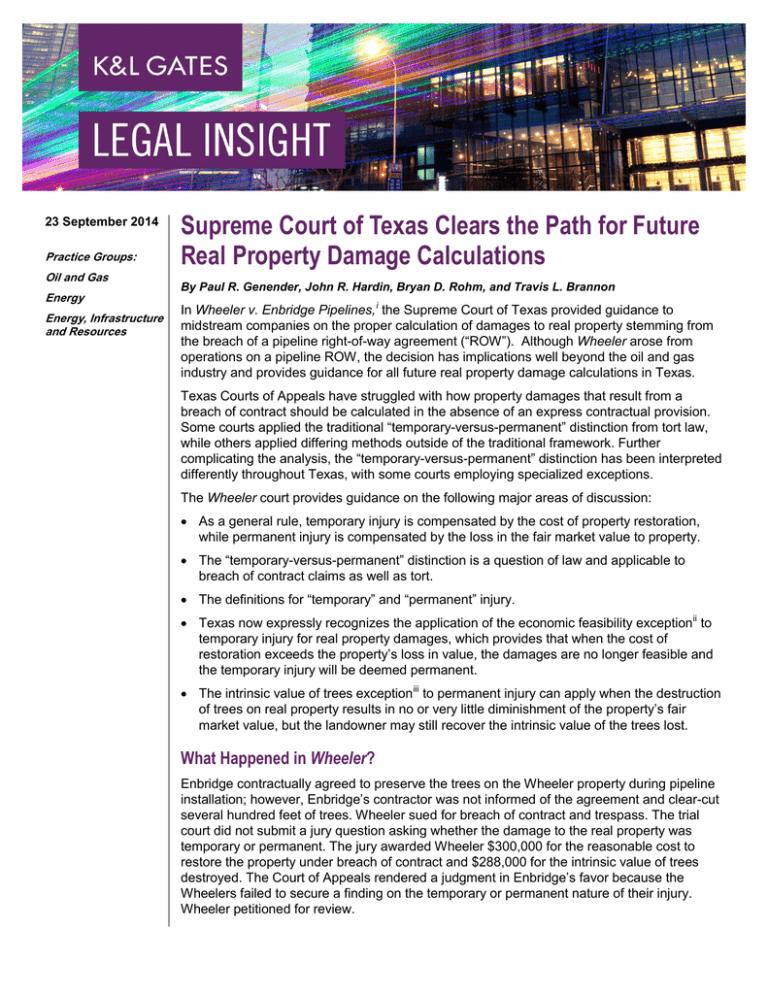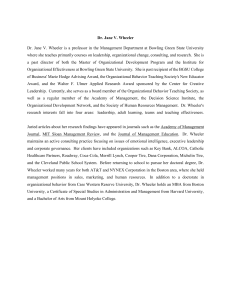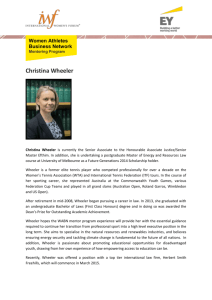
23 September 2014
Practice Groups:
Oil and Gas
Energy
Energy, Infrastructure
and Resources
Supreme Court of Texas Clears the Path for Future
Real Property Damage Calculations
By Paul R. Genender, John R. Hardin, Bryan D. Rohm, and Travis L. Brannon
In Wheeler v. Enbridge Pipelines, i the Supreme Court of Texas provided guidance to
midstream companies on the proper calculation of damages to real property stemming from
the breach of a pipeline right-of-way agreement (“ROW”). Although Wheeler arose from
operations on a pipeline ROW, the decision has implications well beyond the oil and gas
industry and provides guidance for all future real property damage calculations in Texas.
Texas Courts of Appeals have struggled with how property damages that result from a
breach of contract should be calculated in the absence of an express contractual provision.
Some courts applied the traditional “temporary-versus-permanent” distinction from tort law,
while others applied differing methods outside of the traditional framework. Further
complicating the analysis, the “temporary-versus-permanent” distinction has been interpreted
differently throughout Texas, with some courts employing specialized exceptions.
The Wheeler court provides guidance on the following major areas of discussion:
• As a general rule, temporary injury is compensated by the cost of property restoration,
while permanent injury is compensated by the loss in the fair market value to property.
• The “temporary-versus-permanent” distinction is a question of law and applicable to
breach of contract claims as well as tort.
• The definitions for “temporary” and “permanent” injury.
• Texas now expressly recognizes the application of the economic feasibility exceptionii to
temporary injury for real property damages, which provides that when the cost of
restoration exceeds the property’s loss in value, the damages are no longer feasible and
the temporary injury will be deemed permanent.
• The intrinsic value of trees exceptioniii to permanent injury can apply when the destruction
of trees on real property results in no or very little diminishment of the property’s fair
market value, but the landowner may still recover the intrinsic value of the trees lost.
What Happened in Wheeler?
Enbridge contractually agreed to preserve the trees on the Wheeler property during pipeline
installation; however, Enbridge’s contractor was not informed of the agreement and clear-cut
several hundred feet of trees. Wheeler sued for breach of contract and trespass. The trial
court did not submit a jury question asking whether the damage to the real property was
temporary or permanent. The jury awarded Wheeler $300,000 for the reasonable cost to
restore the property under breach of contract and $288,000 for the intrinsic value of trees
destroyed. The Court of Appeals rendered a judgment in Enbridge’s favor because the
Wheelers failed to secure a finding on the temporary or permanent nature of their injury.
Wheeler petitioned for review.
Supreme Court of Texas Clears the Path for Future Real
Property Damage Calculations
Key Holdings and Analysis
Application to Breach of Contract Claims
The Court held that classifying injury to real property as either permanent or temporary
applies to breach of contract and tort claims. While contracting parties are free to specify
how damages will be calculated, when they do not, “both courts and parties benefit from the
application of general principles with respect to calculating damages for such injury.”
Definitions of Temporary and Permanent Injury
For clarity, the Court defined temporary and permanent injury:
• “An injury to real property is considered permanent if (a) it cannot be repaired, fixed, or
restored, or (b) even though the injury can be repaired, fixed, or restored, it is
substantially certain that the injury will repeatedly, continually, and regularly recur, such
that future injury can be reasonably evaluated.”
• “Conversely, an injury to real property is considered temporary if (a) it can be repaired,
fixed, or restored, and (b) any anticipated recurrence would be only occasional, irregular,
intermittent, and not reasonably predictable, such that future injury could not be estimated
with reasonable certainty injury.”
“Temporary-versus-Permanent” as a Question of Law
The Court held that “whether an injury is temporary or permanent is a question of law for the
court to decide.” However, “when the facts are disputed and must be resolved to correctly
evaluate the nature of the injury, the court . . . must present the issue to the jury, relying on
the definitions we have provided in this opinion.” In this case, the Court held that the injury to
the Wheeler property is permanent because of: (i) the parties’ agreement and acquiescence
in the briefs, and (ii) the economic feasibility exception (discussed below) converts the injury
from temporary to permanent.
Economic Feasibility Exception
The economic feasibility exception provides that, when the cost of restoration exceeds the
property’s loss in value, the damages are no longer feasible and the temporary injury will be
deemed permanent. Prior to Wheeler, the Supreme Court of Texas had not formally
recognized the economic feasibility exception, although it had applied similar concepts to
prevent overcompensation to landowners. In Wheeler, the court expressly adopted the
exception and applied it because the diminution in the fair market value of the land was
between $0 and $3,000, while the cost of restoration was $300,000.
Intrinsic Value of Trees Exception
Generally, the Court affirmed the “intrinsic value of trees” exception in Texas and clarified
that it could apply, even if the diminution to the property value was nominal. Again, the court
compared the $3,000 diminution in value to the $383,000 fair market value of the property,
and concluded that the exception was appropriate for the circumstances in Wheeler.
2
Supreme Court of Texas Clears the Path for Future Real
Property Damage Calculations
Following the above analysis and holdings, the Court reversed the Court of Appeals and
remanded the case to that court to address any remaining issues in a manner consistent with
the opinion.
What is Wheeler’s impact?
Wheeler clarifies how to value real property damages arising from pipeline ROWs. Wheeler
makes it difficult (if not impossible) for landowners to recover damages that exceed the fair
market value of the property. Although Wheeler clarified the damages calculation if an
agreement is silent, the best way to address the issues remains a clear contract provision
that delineates the calculation and valuation of timber and/or surface damages. To the extent
timber or other surface damages are not expressly provided for in a ROW, midstream
companies may wish to consider either: (i) revising standard ROW forms to include a clear
contract provision addressing timber and real property damages or (ii) for existing ROWs,
entering into side-letter agreements with landowners to specify the calculation and payment
of timber and/or surface damages prior to conducting surface operations.
Authors:
Paul R. Genender
paul.genender@klgates.com
+1.214.939.5660
John R. Hardin
john.hardin@klgates.com
+1.214.939.5612
Bryan D. Rohm
bryan.rohm@klgates.com
+1.412.355.8682
Travis L. Brannon
travis.brannon@klgates.com
+1.412.355.7443
Anchorage Austin Beijing Berlin Boston Brisbane Brussels Charleston Charlotte Chicago Dallas Doha Dubai Fort Worth Frankfurt
Harrisburg Hong Kong Houston London Los Angeles Melbourne Miami Milan Moscow Newark New York Orange County Palo Alto Paris
Perth Pittsburgh Portland Raleigh Research Triangle Park San Francisco São Paulo Seattle Seoul Shanghai Singapore Spokane
Sydney Taipei Tokyo Warsaw Washington, D.C. Wilmington
K&L Gates comprises more than 2,000 lawyers globally who practice in fully integrated offices located on five
continents. The firm represents leading multinational corporations, growth and middle-market companies, capital
markets participants and entrepreneurs in every major industry group as well as public sector entities, educational
institutions, philanthropic organizations and individuals. For more information about K&L Gates or its locations,
practices and registrations, visit www.klgates.com.
This publication is for informational purposes and does not contain or convey legal advice. The information herein should not be used or relied upon in
regard to any particular facts or circumstances without first consulting a lawyer.
© 2014 K&L Gates LLP. All Rights Reserved.
3
Supreme Court of Texas Clears the Path for Future Real
Property Damage Calculations
i
---S.W.3d---, No. 13-0234, 2014 WL 4252273 (Tex. Aug. 29, 2014).
See e.g. N. Ridge Corp. v. Walraven, 957 S.W.2d 116, 119 (Tex. App.-Eastland 1997, pet. denied).
iii
See Porras v. Craig, 675 S.W.2d 503, 504 (Tex. 1984) (creating the exception to compensate landowners
for the loss of the aesthetic utilitarian value that trees confer on real property).
ii
4



